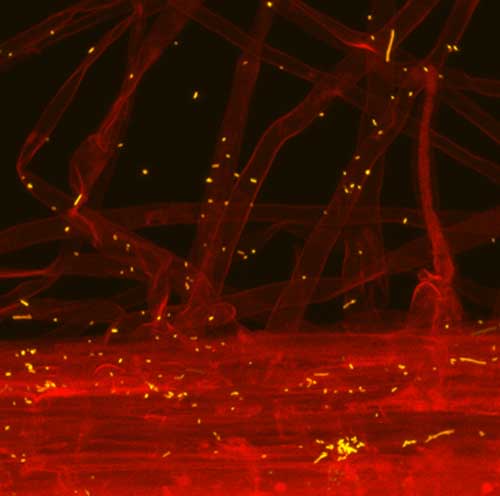Food-Borne Bacteria And Ready-To-Eat Fresh Produce: Implications For Food Safety
Published on 25 January 2010 in Food, health and wellbeing
Introduction
Plant disease control can take many forms and at SCRI we have recently expanded this area to include colonisation of plants by human pathogenic bacteria. Food-borne pathogens pose a serious threat to food safety in the UK. The government recognises that in rich countries, people are more likely to die of food poisoning than of starvation. While the majority of food-borne bacteria are carried by animals (zoonotic pathogens), there has been an increase in the number of outbreaks from consumption of contaminated produce, especially ready-to-eat items. We have shown that the bacteria actively interact with plants and can colonise them as alternative hosts.
Key Points
The majority of bacterial pathogens implicated in fresh-produce outbreaks are zoonotic bacteria, which are normally associated with their animal hosts. However, a key feature of this group of bacteria is their ability to adapt to a wide variety of environments, including plants. Our work indicates that these pathogens share many features with related plant pathogenic bacteria that enable colonisation of plants.
Research Undertaken
The research covers two main aspects of bacterial colonisation of plants. Firstly the processes of bacterial colonisation of plants: how the bacteria initially interact with plants; which bacterial factors are required; how colonisation becomes established; where the bacteria reside in the plant tissue; and how the plants respond to the bacteria (Fig. 1).

Figure 1: Human pathogenic bacteria (Escherichia coli O157:H7) labelled in green colonising a spinach root, coloured red. The long red projections from the main root are the root hairs. Individual bacteria can be seen interacting with the root hairs. There is also formation of micro-colonies of bacteria on the main segment of the root, suggesting that they are able to grow and divide on the root surface.
We have found that there are specific interactions between the bacterium and plant host during the initial stages of colonisation. However, the exact nature of the interaction is still to be elucidated and appears to involve multiple factors.
Comparisons of the genetic information of human pathogenic enterobacteria have been carried out with bacteria that are mostly or exclusively associated with plants. The analysis has revealed the presence of a number of genes that appear to have shared ancestry and may play a fundamental role in colonisation of plants.
Secondly, we aim to understand transmission of the zoonotic bacteria from animal hosts in to crop plants. Trial sites that have been supplemented with farm waste have been screened for the presence of enterobacteria normally associated with humans and animals. It is possible to detect the bacteria from this site throughout the growing season and into harvest time. This reinforces the finding that these bacteria are perfectly able to adapt to conditions quite different from their animal hosts.
Work with others at SCRI whose focus is either on related bacteria that cause plant disease, or on whole microbial population interactions with plants and soil has enabled investigation of the bacterial populations on plants, which in turn, will help us to predict the spread of the main food-borne bacterial pathogens.
Policy Implications
At the present time, the number of outbreaks from fresh produce is relatively small. However, there has been a steady rise in outbreaks over the past two decades or so, while the incidence from farm-animal products is declining.
Scientists are now working to find the reasons for the increase with the long term aim of reducing carriage and maintaining the safety of fresh produce. This is particularly important for producer, retailer and consumer confidence in an era of promoting a healthy diet, of which fresh produce is a fundamental component.
Another important aspect that could influence transmission of food-borne bacteria is the changes in farming and production strategies in response to climate change. The increased drive for sustainable practices such as application of waste on fields, in the form of municipal compost or animal manure, is likely to increase the numbers of zoonotic bacteria on fields and potentially provides a direct route of transmission to crops. Therefore, it is important to fully understand the risk involved and the downstream implications for food safety.
Author
Dr Nicola Holden, SCRI Nicola.Holden@scri.ac.uk





